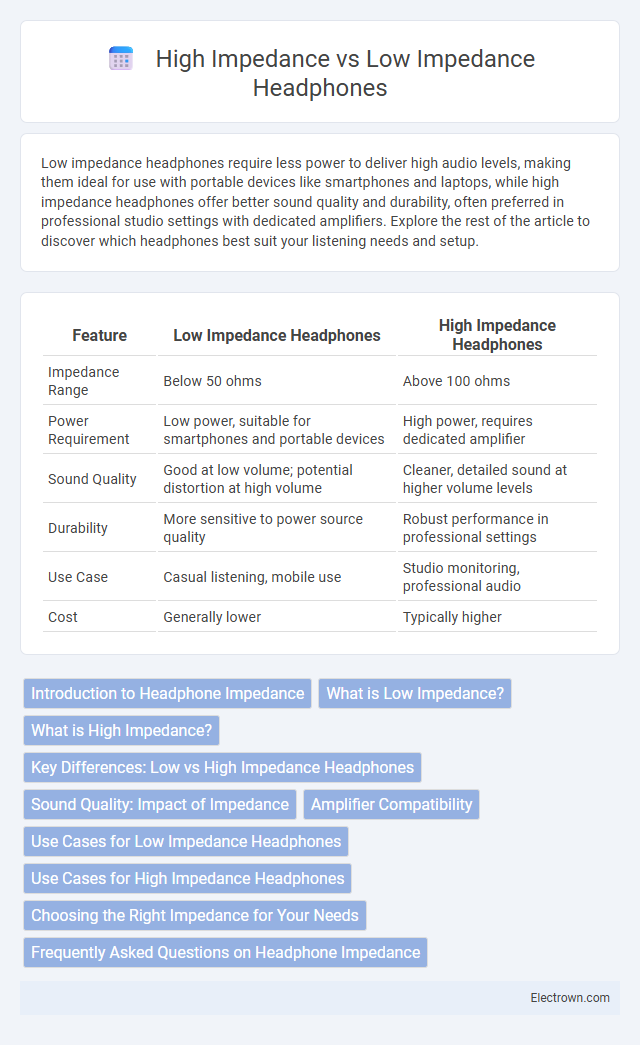Low impedance headphones require less power to deliver high audio levels, making them ideal for use with portable devices like smartphones and laptops, while high impedance headphones offer better sound quality and durability, often preferred in professional studio settings with dedicated amplifiers. Explore the rest of the article to discover which headphones best suit your listening needs and setup.
Table of Comparison
| Feature | Low Impedance Headphones | High Impedance Headphones |
|---|---|---|
| Impedance Range | Below 50 ohms | Above 100 ohms |
| Power Requirement | Low power, suitable for smartphones and portable devices | High power, requires dedicated amplifier |
| Sound Quality | Good at low volume; potential distortion at high volume | Cleaner, detailed sound at higher volume levels |
| Durability | More sensitive to power source quality | Robust performance in professional settings |
| Use Case | Casual listening, mobile use | Studio monitoring, professional audio |
| Cost | Generally lower | Typically higher |
Introduction to Headphone Impedance
Headphone impedance, measured in ohms (O), determines how much electrical resistance headphones present to an audio source. Low impedance headphones (typically under 50 O) require less voltage and are ideal for use with portable devices like smartphones and laptops, delivering louder sound with less power. High impedance headphones (above 100 O) need more voltage, often paired with dedicated amplifiers to achieve optimal sound quality and reduced distortion.
What is Low Impedance?
Low impedance headphones typically have an impedance rating below 50 ohms, making them easier to drive with portable devices like smartphones and laptops without requiring powerful amplifiers. They draw more current, which results in higher volume levels at lower power inputs, ideal for casual listening on the go. Low impedance headphones are best suited for devices with limited output power, ensuring compatibility and efficient performance.
What is High Impedance?
High impedance headphones typically have an impedance above 100 ohms, requiring more power to deliver optimal sound levels. They are designed for use with professional audio equipment or amplifiers that can provide the necessary voltage for clear and detailed audio reproduction. High impedance minimizes distortion and allows for better sound quality in controlled listening environments.
Key Differences: Low vs High Impedance Headphones
Low impedance headphones typically range from 16 to 80 ohms, allowing them to be easily driven by portable devices like smartphones and laptops, whereas high impedance headphones generally exceed 100 ohms and require dedicated amplifiers for optimal performance. The key differences include power requirements, with low impedance models demanding less voltage and offering higher sensitivity, while high impedance headphones provide better sound quality, reduced distortion, and improved control at higher output levels. Audio professionals often prefer high impedance headphones for studio monitoring due to their accuracy and ability to handle powerful amplifiers, while casual listeners benefit from the convenience and compatibility of low impedance headphones.
Sound Quality: Impact of Impedance
Low impedance headphones (typically under 50 ohms) offer compatibility with most portable devices, delivering clear and dynamic sound with less power needed. High impedance headphones (above 100 ohms) require specialized amplifiers to reach optimal volume but provide superior sound quality through reduced distortion and enhanced detail resolution. The impedance level directly influences the headphone's efficiency, frequency response, and overall audio fidelity.
Amplifier Compatibility
Low impedance headphones typically range from 16 to 50 ohms and are easily driven by portable devices like smartphones and laptops without requiring an external amplifier. High impedance headphones, often above 100 ohms, demand more power and usually pair best with dedicated headphone amplifiers to achieve optimal sound quality and volume levels. Ensuring your amplifier compatibility with the headphone's impedance is crucial for preventing distortion and maximizing audio performance.
Use Cases for Low Impedance Headphones
Low impedance headphones, typically rated below 50 ohms, are ideal for use with portable devices such as smartphones, tablets, and laptops due to their ability to draw power efficiently from low-voltage sources. These headphones deliver high volume levels and better sound output without requiring a dedicated amplifier, making them suitable for casual listening on the go. Users seeking convenience and compatibility with everyday consumer electronics benefit most from low impedance designs.
Use Cases for High Impedance Headphones
High impedance headphones, typically rated above 100 ohms, are suited for professional audio environments such as studios where high-quality audio interfaces and amplifiers provide sufficient power. They excel in delivering precise sound reproduction with minimal distortion, making them ideal for audio mixing and mastering applications. These headphones are less compatible with portable devices like smartphones without a dedicated headphone amplifier due to their power requirements.
Choosing the Right Impedance for Your Needs
Low impedance headphones, typically under 50 ohms, are ideal for use with portable devices like smartphones and laptops due to their ability to deliver high volume at lower power levels. High impedance headphones, generally above 100 ohms, require more power and are best suited for professional audio equipment or dedicated headphone amplifiers, offering superior sound quality and detailed audio reproduction. Selecting the right impedance depends on matching the headphones with your audio source to ensure optimal performance and prevent distortion or insufficient volume.
Frequently Asked Questions on Headphone Impedance
Low impedance headphones, typically ranging from 16 to 32 ohms, require less power and are ideal for use with smartphones and portable devices due to their easy drivability. High impedance headphones, generally above 100 ohms, demand more power but offer superior sound quality and are preferred in professional audio environments with dedicated amplifiers. Understanding the difference helps users select the right headphones based on their audio source capability and desired sound performance.
low impedance vs high impedance headphones Infographic

 electrown.com
electrown.com